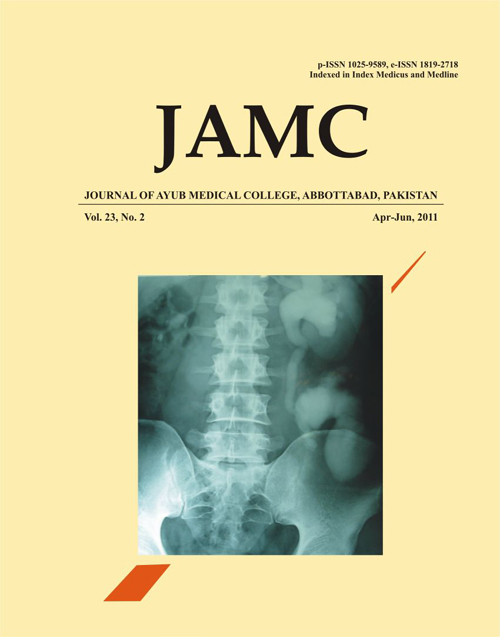MODIFIED ACID FAST STAINING: A BETTER DIAGNOSTIC TOOL IN CHRONIC DIARRHOEA DUE TO CRYPTOSPORIDIOSIS
Abstract
Background: Cryptosporidium parvum is an emerging pathogen responsible for chronic diarrhoea inchildren and immuno-compromised individuals, especially AIDS patients. Currently, there is noeffective therapeutic strategy for treating cryptosporidiosis, therefore control and supportivetreatment of cryptosporidiosis depends upon rapid and accurate diagnosis of this infection.Methodology: A descriptive study was conducted in the Pathology Department of Khyber MedicalCollege and Pathology Laboratory of Khyber Teaching Hospital over a period of one year March2007–April 2008. A total of 200 stool samples were tested for the presence of C. parvum oocystsfrom children <5 years age suffering from diarrhoea for >5 days. Total and differential leukocytecount was determined to assess immune status of the patients. Modified Ziehl-Neelsen (Z-N)staining, a rapid, sensitive and easy test, was used successfully for the detection of C. parvumoocysts in stool specimen. Results: Cryptosporidium oocysts were found in 18 (9.0%) samples. Outof 18 positive cases, 13 (72.2%) children had lymphopenia hence their immune status was impaired.Infection was common in children between 1–24 months of age. Mean duration of diarrhoea was 11months. Most of C. parvum infected children were consumers of well water (77.8%). Conclusion:Cryptosporidiosis, although a self-limiting disease, rarely investigated routinely, can become chronicand life threatening in immuno-compromised individuals. Majority of affected patients are immunecompromised. Modified Z-N is a sensitive and rapid method which can explore the gravity of thisinfection even further if used routinely and may control morbidity and mortality associated with thisinfection.Keywords: Chronic diarrhoea, modified Ziehl-Neelsen staining, immuno-comprisedReferences
Shoaib S, Tauheed S, Hafiz A. Frequency of Cryptosporidium in
childhood diarrhoea importance of modified acid fast technique. J
Ayub Med Coll Abbottabad 2003;3:3–5.
Chappell CL, Okhuysen PC, Cryptosporidiosis. Current Opin
Infect Dis 2005;15:523–7.
Guerrant RL. Cryptosporidiosis: an emerging highly infectious
threat. Emerg Infect Dis 1997;3:51–7.
Bhutta, ZA. Persistent diarrhoea in developing countries. Ann
Nestle 2006;64:39–47.
Thielman NM, Guerrant RL. Acute infectious diarrhoea. N Eng J
Med 2004;350:38–47.
Vakil NB, Schwartz SM, Buggy BP, Brummitt CF, Kherellah M,
Letzer DM, et al. Biliary cryptosporidiosis in HIV infected
people after the water borne outbreak of Cryptosporidiosis in
Milwaukee. N Eng J Med 1996;334:19–23.
Roy SL, Delong SM, Stenzel SA, Shiferaw B, Roberts JM,
Khalakdina A, et al. Risk factor for sporadic Cryptosporidiosis
among immuno-competent persons in the United States from
to 2001. J Clin Microbiol 2004;42:2944–51.
Gaash B. Cryptosporidiosis. Ind Medica 2006;3:1–7.
Ajjampur SSR, Gladstone BP, Selvar D, Muliyil P, Ward H,
Kang G. Molecular and spatial epidemiology of cryptosporidiosis
in semi urban community in South India. J Clin Microbiol
;45:915–20.
Banwat EB, Egah DZ, Audu ES, Onile BA, Datong PR.
Cryptosporidium infection in undernourished children with
HIV/AIDS in Jos, Nigeria. Annals Afr Med 2004;3:80–2.
Mahgoub ES, Al-Mahbashi A, Abdulatif B. Cryptosporidiosis in
children in North Jordanian Paediatric Hospital. Eastern Mediter
Health J 2004;10:494–501.
Iqbal J, Munir MA, Khan MA. Cryptosporidium infection in
young children with diarrhoea in Rawalpindi, Pakistan. Am J
Trop Med Hyg 1999;60:868–70.
Morgan UM, Pallant L, Dwyer BW, Forbes DA, Rich G,
Thompson RCA. Comparison of PCR and microscopy for
detection of Cryptosporidium parvum in human fecal specimens,
Clinical trial. J Clin Microbiol 1998;36:995–8.
Agnew DG, Lima AAM, Newman RD, Wuhib T, Moore RD,
Guerrant RL, Sears CL. Cryptosporidiosis in Northeastern
Brazilian children: association with increased diarrhoeal
morbidity. J infect Dis 1998;177:754–60.
Laubach HE, Bentlay CZ, Ginter EL, Spalter JS, Jensen LA. A
study of risk factors associated with the prevalence of
Cryptosporidium in villages around lake Atitlan, Guatemala.
Braz J Infect Dis 2004;8:1–7.
Rashidul-Haque. Human intestinal parasites. J Health Popul
Nutri 2007;25:387–91.
Mahdi NK, Al-Sadoon IA, Mohamed AT. First report of
cryptosporidiosis among Iraqi children. Eastern Mediter Health J
;2:115–20.
Abu Alrub SM, Abusada GM, Farraj MA, Essawi TA.
Prevalence of Cryptosporidium spp. in children with diarrhoea in
the west Bank Palestine. J Infect Develop Countr 2008;2:59–62.
Nimri LF, Batchoun R. Prevalence of cryptosporidium species in
elementary school children. J Clin Microbiol 1994;32:1040–2.
Newman RD, Zu S-X, Wuhib T, Lima AAM, Guerrant RL,
Sears CL. Household epidemiology of Cryptosporidium parvum
infection in an urban community in Northeast Brazil. Annal Inter
Med 1994;120:500–5.
Baqai R, Anwar S, Kazmi SU. Detection of cryptosporidium in
immune-suppressed patients. J Ayub Med Coll Abbottabad
;17:3.
Nagamani K, Pavuluri PRR, Gyaneshwari M, Prasanthi K, Rao
MIS, Saxena NK. Molecular characterization of
Cryptosporidium: an emerging Parasite. Indian J Med Microbiol
;25:133–6.
Published
Issue
Section
License
Journal of Ayub Medical College, Abbottabad is an OPEN ACCESS JOURNAL which means that all content is FREELY available without charge to all users whether registered with the journal or not. The work published by J Ayub Med Coll Abbottabad is licensed and distributed under the creative commons License CC BY ND Attribution-NoDerivs. Material printed in this journal is OPEN to access, and are FREE for use in academic and research work with proper citation. J Ayub Med Coll Abbottabad accepts only original material for publication with the understanding that except for abstracts, no part of the data has been published or will be submitted for publication elsewhere before appearing in J Ayub Med Coll Abbottabad. The Editorial Board of J Ayub Med Coll Abbottabad makes every effort to ensure the accuracy and authenticity of material printed in J Ayub Med Coll Abbottabad. However, conclusions and statements expressed are views of the authors and do not reflect the opinion/policy of J Ayub Med Coll Abbottabad or the Editorial Board.
USERS are allowed to read, download, copy, distribute, print, search, or link to the full texts of the articles, or use them for any other lawful purpose, without asking prior permission from the publisher or the author. This is in accordance with the BOAI definition of open access.
AUTHORS retain the rights of free downloading/unlimited e-print of full text and sharing/disseminating the article without any restriction, by any means including twitter, scholarly collaboration networks such as ResearchGate, Academia.eu, and social media sites such as Twitter, LinkedIn, Google Scholar and any other professional or academic networking site.









